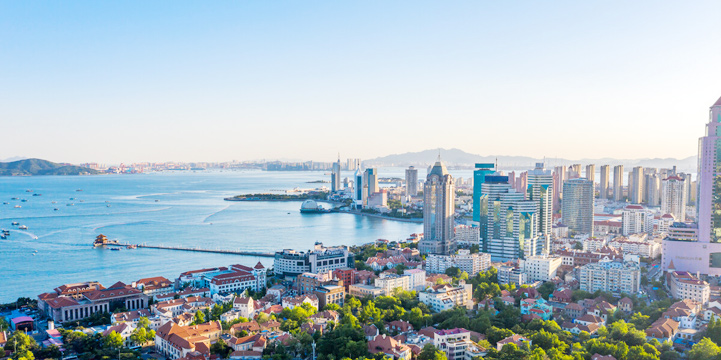In 2017, for the global container ship market, it was destined to be an extraordinary year. South Korea's largest liner company, Hanjin Shipping, was officially bankrupted and liquidated, ending its 40-year-old container shipping business; the global container shipping market alliance has entered a new era. Three-legged era; Maersk Line’s acquisition of Hamburg South America, Hapag-Lloyd’s merger with UAE’s combined shipping, COSCO Marine’s announcement of the acquisition of Hong Kong Orient Overseas, and the further increase in the global container shipping market concentration; CMA and Mediterranean Shipping have set a batch of 22,000 TEU extra large Container ships, the global container shipbuilding market officially entered the era of 22,000 TEU.
1. The shipping market is showing a steady state trend
In 2017, the global container shipping market showed a steady trend. At the beginning of the year, due to the seasonal fall in container shipping demand in Europe and the United States, CCFI appeared to be slightly loose. Since then, with the continuous improvement of the global economic situation, especially the active regional economy and trade, the container shipping volume has been steadily increasing. At the same time, shipping companies have intensified their control efforts and capacity. The relationship between supply and demand has steadily improved. The box-ship market has returned to the upstream channel and has shown a trend towards stability. In 2017, the CCFI of the global container shipping market averaged 820 points, up 15.2% year-on-year. With the improvement of the global container shipping market, the size of idle capacity has been greatly reduced. According to the statistical data of AXS-Alphaliner, a French maritime consulting agency, as of the end of December 2017, the global idle container shipping capacity was only 117 and 416,000 TEU. It accounts for 2% of the global container fleet size, which is also the lowest level since the beginning of 2015, which is much lower than the idle peak of 400 vessels in the middle of 2016.
The
2. Liner company performance improved
Since 2017, with the improvement of the global container shipping market, the performance of major liner companies has improved significantly. Among them, Maersk Shipping of Denmark achieved operating revenue of 17.7 billion U.S. dollars, an increase of 15.1% year-on-year; net profit of 493 million U.S. dollars, compared with a loss of 230 million U.S. dollars in the same period of last year. Hapag-Lloyd achieved a net profit of 8.2 million euros in the first three quarters of 2017, turning it into a profit. Among Taiwan's three largest liner companies, Evergreen Shipping achieved operating revenue of NT 113.068 billion, which was a year-on-year increase of 25.2%; net profit was NT 7.089 billion. Wan Hai Shipping continued its profitable trend. Revenue for the first three quarters of 2017 was NT$44.969 billion, an increase of 5.9% year-on-year; net profit was NT$1.983 billion. Yangming Shipping achieved operating revenue of NT$99.263 billion in the first three quarters of 2017, an increase of 18.3% year-on-year; net profit was NT$612 million. It is worth noting that Hyundai Merchant Marine is still in a loss situation, with a net loss of 966.8 billion won in the first three quarters of 2017.
The
3, further increase the concentration
Since 2017, the global container shipping market structure has continued to adjust, and the shipowners have been warming up. The merger and reorganization events between liner companies have accelerated and the market concentration has been further strengthened. In April 2017, Maersk Line of Denmark announced the acquisition of Hamburg, South America. In May 2017, German Hapag-Lloyd announced the merger with the United Arab Emirates. In September 2017, COSCO Shipping announced the acquisition of Orient Overseas. Judging from the specific acquisition process, in December 2017, after completing the regulatory approval process in 23 jurisdictions around the world, Maersk Line officially announced the closing of Hamburg South America. Hamburg South America will continue to operate as an independent brand in the future. At the same time, Germany's Hapag-Lloyd completed the final merger of the United Arab Shipping, the formation of the world's fifth-largest liner companies. In addition, the acquisition of OOCL by COSCO SHIPPING is also under way. It has passed the US anti-monopoly review in October and December of last year and the European Commission’s anti-monopoly review. It is expected that the final acquisition will be completed by April 2018. According to the statistics of AXS-Alphaliner, a French maritime consulting agency, as of the end of December 2017, the concentration of transportation capacity of the top 10 liner companies in the world was as high as 77.3%, and the market concentration was further enhanced.
The
4, the new alliance structure opened
In 2017, the global container shipping market alliance structure has further evolved. In April, the new OCEAN Alliance, THE Alliance and the “2M+ Modern Merchant Shipping” three alliances formally started to dominate the global container shipping market. The global container shipping market opened a new historical chapter. The past 2M, O6, CKYHE and O3 The four major leagues no longer exist. As of the end of December 2017, the container ship capacity of OCEAN Alliance, THE Alliance and “2M+ Hyundai Merchant Shipping” were 6.071 million TEU, 3.635 million TEU, and 7.632 million TEU, respectively, and their market share was 28.2% and 16.9% respectively. Together with 35.4%, the total capacity of the three major alliance members reached 17.333 million TEU, with a total market share of 80.5%.
